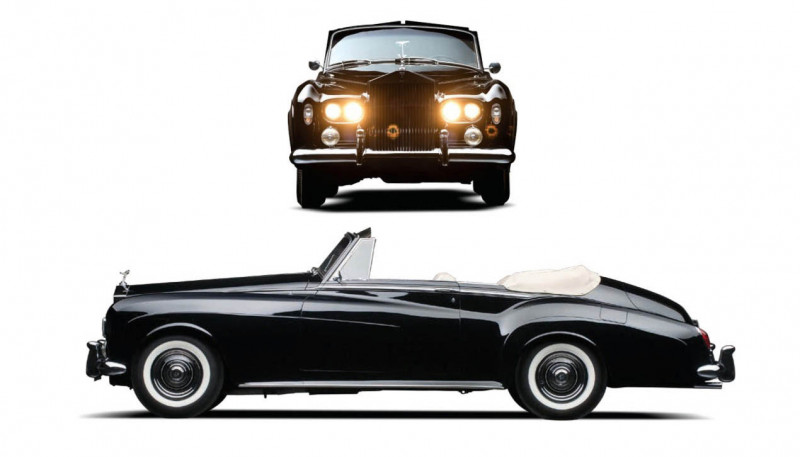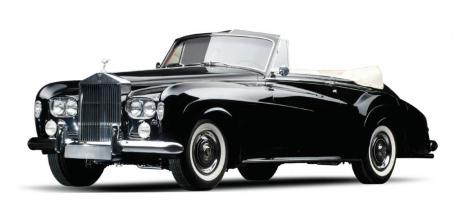1965 Rolls-Royce Silver Cloud Drophead Coupe
Cloud with a silver lining. Coupe and convertible versions kept the coachbuilding tradition alive
It’s hard to imagine any snootier car owners than those of Rolls-Royce, but in fact, that’s just the beginning. Within those Roller ranks there’s another world of sub-snobbery, separating Derby from Crewe build, coachbuilt from ‘production’ body, left- from right-hand drive, which rock star parked it in a swimming pool, and who knows what else.

A major divider lies at the Silver Cloud model, of which some 13,000 were built across three series from 1955-1965. The Cloud (and sister Bentley S) was the last of the traditional, separate-chassis Rolls-Royces and the first to be fitted with series-produced, in-house bodies.
The Cloud’s replacement in 1965 with the full monocoque-bodied Silver Shadow would deal a crippling blow to traditional British coachbuilding.
No less significant was the replacement, with the Silver Cloud Series II in 1959, of the brand’s 4.9-litre, iron-block in-line six-cylinder engine with an all-alloy V8 that would be synonymous with the brand – and with later-estranged sister Bentley – for more than 60 years.
The ‘L series’ V8 is often wrongly described as a copy of an American V8, which rather underestimates the engineering talent within Rolls-Royce after World War 2. Its designer Jack Phillips benchmarked the Cadillac overhead-valve and Chrysler Hemi V8s, but his 6.2-litre L series had a unique set of parameters.
The new engine had to be 50 percent more powerful than the outgoing six-cylinder, no less smooth or silent, and ideally no heavier or more costly to produce. Crucially, it also had to comply with the Cloud’s narrow engine bay; such that a removable panel in the right-front wheel-well was the only means of accessing the right bank’s spark plugs.
The Series III cars, introduced in 1962, were easily recognised by more modish quad headlamps. While coachbuilds had been few among the S1 and S2 Clouds, the end of the handbuilt Silver Wraith limousine (1947-1959) helped accelerate interest in coachbuilt bodies for the Cloud S3, the end of the separate-chassis era.
Notable among them were 100 coupes and convertibles produced by HJ Mulliner Park Ward, continuing a 1959 Park Ward design for the Bentley S2 Continental. The straight shoulder-line, angled quad headlamps and tailfins were elegant and modern, whether in hardtop or ‘drop-head coupe’, like this 1965 example that was delivered new to UK movie mogul and hapless rhyming slang victim, J. Arthur Rank.
THE ART OF ADEQUATE
Rolls-Royce’s 6230cc, 90-degree ohv V8 was an entirely in-house design, an all-alloy unit with steel wet liners. Early production reliability issues prompted a bottom-end redesign for 1961. Power outputs famously weren’t quoted, but for 1962 the S3 version gained “perhaps 7 percent” through higher compression and bigger SU carbs. Via a tweaked GM Hydramatic four-speed, a S3 went from 0-100km/h in about 11 seconds and had a top speed of 185km/h.
CRAFTED BY HAND
With Rolls-Royce offering no in-house coupe or convertible of its own, a coachbuilt S3, on the full-length sedan wheelbase, was especially prized as a more spacious and prestigious alternative to a Bentley. The interiors were poetry in Connolly leather and walnut veneer, this coachbuilt car’s instruments being more pleasing than the standard sedan’s centre cluster. Air-con was a factory option, as was power steering – the latter a necessity, given the 2.1-tonne kerb weight.
IN DETAIL
- 2044 total Silver Cloud Series 3built(1962-1965)
- 1961 merger of HJ Mulliner and ParkWard coachbuilders
- 61 Years of eventualservice from theL-series ‘6.’ V8
- 185 km/h top speed


